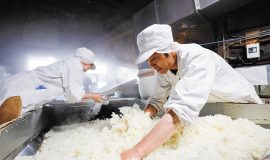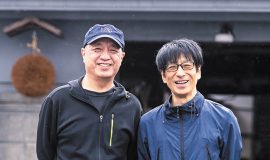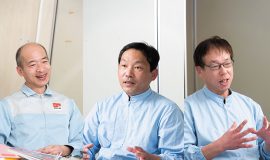The brew arrived at from the ups and downs and sharing the techniques and ideas from it openly

Open with our know-how, we just want to make good sake together
“A research-oriented idea generator”. Such words would best describe Aihara. Ideas, ingenuity and originality abound are dotted throughout the brewery. There are simply countless things that strike a chord and make one exclaim “I see!”
Take for example the batch-type bottle pasteurization machine installed outside between the main building and the brewery. The bottles are lined up neatly in a row after being corked, as though sitting in a hot spring. Unlike the U-shaped machines, this one raises the temperature and then adds water for rapid cooling.
“The reason we opted for a batch style is that it keeps the temperature difference between the top and bottom to less than 1 degree. This bottle-pasteurization machine that uses this know-how is our own, but some breweries also use the same.”
He then went on to name a few breweries. But is it really okay to share this know-how with other breweries? Then, as though to preempt this question, Aihara said, “I don’t mind you being open about everything to do with us. It’s better for us to make good sake together.”
I recall that there exists a group in Hiroshima Prefecture called the “Konshikai”, formed of six breweries, and Aihara is one of its members. From what I hear, he has been openly providing other members with not only bottle pasteurization know-how, but also any other techniques that were successful in his own brewery, such as the “branch vat” method of brewing and rice washing. The Konshikai was formed after Mr. Murakami of Tenpoichi called together a study group, and Aihara, being the oldest, is a reliable figure for young brewers. With a desire to “raise the standard of breweries in Hiroshima” and to “enliven the sake industry,” the group is completely open with not only its members, but other close brewers from other prefectures.

The temperature difference between the top and bottom can be kept within 1 degree.

A rice washing shower, based on one that was being used at a brewery in Yamagata prefecture.
Ideas galore! Various ingenuity of the brewer
The rice is washed using a Woodson batch rice washer that uses air bubbles. What is distinctive is that two machines are used in parallel, and Aihara Shuzo was the first to wash rice in this style. Furthermore, going one step further is the Aihara-way. He developed the idea of placing a net in the stainless steel basket that catches the rice as it comes out washed, and commercialized it. After the rice is soaked, the net together with the rice is pulled out of the basket, any remaining water removed, and the rice is carefully carried to prevent cracking directly to a shallow wooden bucket and stacked. This eliminates the need for a large number of baskets. Woodson now provides these nets along with the rice washing machine, but it was actually Aihara who birthed the idea.
The vacuum dehydrator is also an original, combining a commercial water-absorbing machine and a measuring instrument. The rice is placed on the scale after soaking, and the machine automatically stops absorbing water once the rice reaches a pre-set weight from drying. In addition, the steamer simulates the principles from an old-fashioned cauldron and the rice is steamed with dry steam in the final stage at 108 degrees celsius.
Another feature typical of this brewery is their thorough temperature control even after the pressing. A Yabuta presser is installed in the refrigerated room in order to maintain the room temperature at 0 degrees for pressing. Then, the next day the lees are removed and the sakeis stored in a thermal tank at minus 5 degrees. In terms of pasteurization, the bottles are heated as described above, but other than that, a plate heat exchanger is used. The heat exchanger itself is not unusual, but it exchanges heat with the hot water through the plate, and once the temperature rises to 65 degrees, it rapidly cools the sake to 12 degrees. The brewery’s nama-zake is stored at minus 5 degrees, so the heat exchange with this sake is what enables the sake to be rapidly cooled to this level. Then after the pasteurization, the sake is still kept at 2 degrees or lower in a chilled room.
In this way, while many enhancements exist, not all are originals. When an idea used at a different brewery is good, then Aihara asks “How do you do it? Let us copy that”, and are quick to implement it. It is becoming of Aihara, who is a passionate researcher with a down to earth personality. If there is any equipment or machinery that interests him, he will ask the breweries that already use it for their opinions.
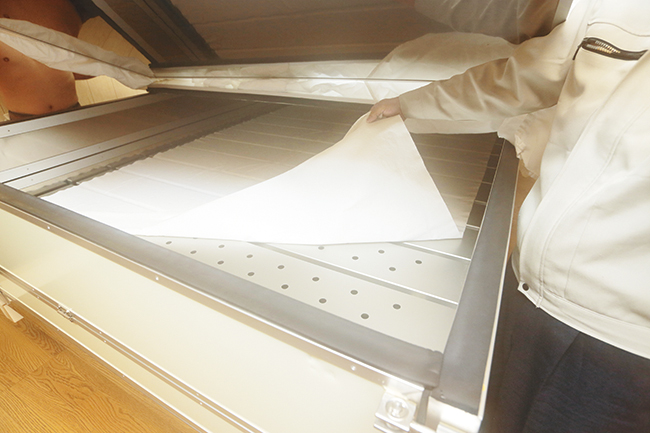
The inside of the floor koji making machine is made of aluminum, not wood.
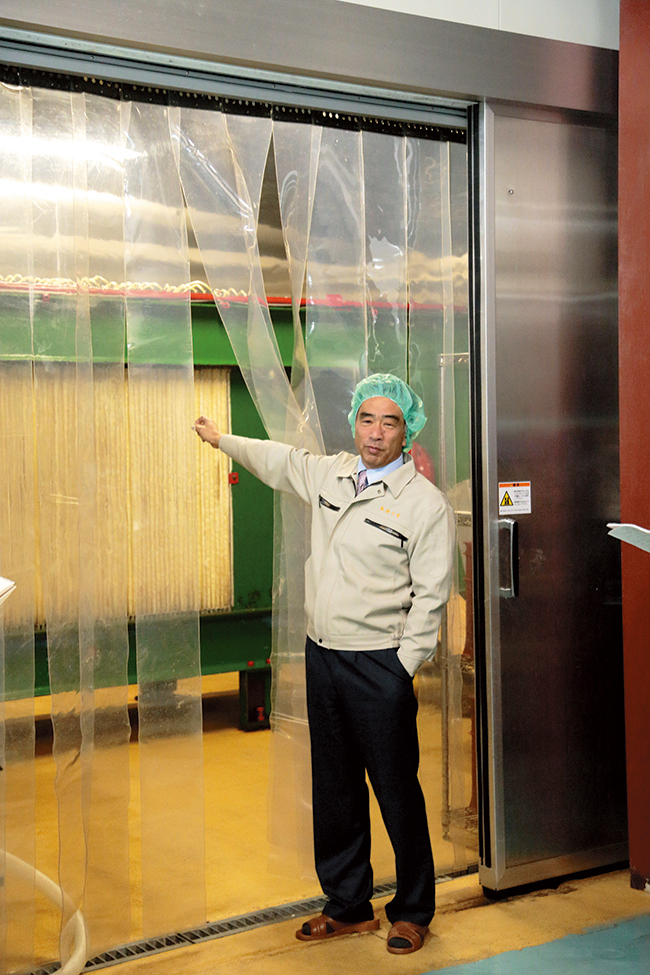
The “joso” process is done in a zero-degree refrigerated room. No lees are removed until the next joso.
1 2


